January 27, 2014
Because there are so many wonderful places to see in the world, it is rather rare for Carol or me to return to a place we’ve been before, no matter how much we enjoyed it. Why, then, am I returning to Cuba only nine months after having been there?
Three reasons, really. First is that Carol was not with me last April and May. I really missed having her there and wished that she had been able to see what I had. When another opportunity arose, I was primed to take it.
Second, Cuba is a wonderful destination. It is close, it is easy to get to, in the same time zone and exotic. And because it is close and easy to get to, one can travel there and not devote an enormous amount of time to the trip. This is a very unusual combination, and makes it a terrific place to travel (or return) to. Though I would not have done another trip to Cuba this soon after my first, unless Carol was coming, I am very happy to be going back with her.
Third, the focus of this trip is on art and music in Cuba. Since both of those areas are of great interest to Carol and me, this seemed like a particularly attractive trip.
We have not yet left home, but already have had one of those amazing coincidental experiences that seem to occur when you travel. For several months in Chicago, I had been working with a personal trainer, so when I went down to Longboat Key to the condo I have rented for the winter, I decided that I should look for a trainer there. I went into the fitness center near my apartment and talked to the manager, who asked me whether I wanted to work with a man or a woman. I told him it didn’t make any difference to me, that I had been working with a man in Evanston. He said, “I think I’ll have you work with Patty.”
In my first session with Patty, we talked about a range of things including the fact that Carol and I were about to go to Cuba. She said, “oh, my husband is Cuban, he immigrated sometime ago.” It turns out that Jorge wound up going to Harvard Business School, had a successful business career and he and Patty had now settled on Longboat Key. I told Patty that Carol and I were going on an art and music trip and she said, “oh, Jorge has a huge Cuban art collection. You and Carol will come over for dinner, Jorge will cook a Cuban meal and I will clean up.”
We had a delightful dinner with Patty and Jorge. Jorge in fact has a terrific Cuban art collection, which he was very happy to show us and talk about. I asked him what was going to occupy his time now that he was retired. He said that his principal project was to write a book on the Cuban artists who he had collected. He is very far along on the book and showed it to us on his iPad. It looks as if not only did Carol and I have a lovely evening, but we have made two new friends in Patty and Jorge, who we’ve invited to come to dinner at our condo when Carol returns to Longboat Key in March.
Jodi and Jasper had been visiting me on Longboat Key, but left yesterday. Things sure do seem quiet when Jasper leaves. Under the guise of trying out my ability to attach photographs to the blog, here’s one of Jasper in Sarasota.
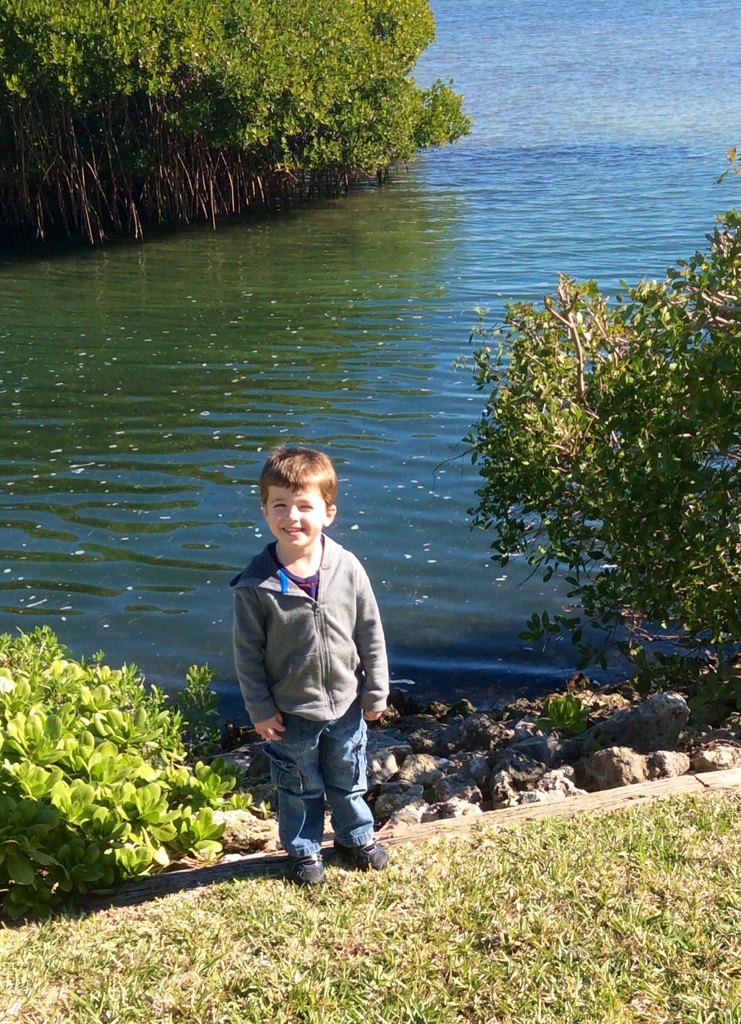
Spent some time packing today, which has never been a big deal to me. You just throw some things (normally too many things) into a suitcase and zip it up. Also spent a bit of time re-reading my blog from last April/May’s Cuba trip, which brought back everything vividly for me, and increased my anticipation for this venture. I’m sure there will be a few repeats from the last trip, but I don’t really mind that. Often when you see something more than once, you come away with a deeper, different or richer appreciation the second time. I’ll be interested to see whether Havana feels any different to me the second time around. Unlike on my earlier trip, we will only be in Havana, and not in Trinidad, as well. I think the greater focus has both advantages and disadvantages. We’ll see how it plays out.
Tomorrow the trip begins. Well, sort of. We meet our group in Miami.
Okay, so I’m cheating. As some of you followers know, I traveled to Cuba last April/May. At that time, I published a map and some historical background on Cuba. I thought about just giving you a link to that post, but decided that there were enough new subscribers and people who would want to refresh their recollections to justify repeating it the way I originally wrote it. So here it is, unmodified. If you want to skip this and pick up with the next post, feel free. Otherwise, for starters, here’s a map.
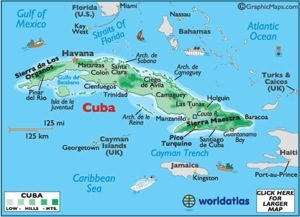
Notice a few things. If you never knew where Gitmo, much in the news, was, now you do, Southeast tip, almost as far as you can get from Havana. Jamaica and the Cayman Islands, both much smaller than Cuba (which is the largest island in the West Indies, about the size of Pennsylvania) are tucked to the South. Although you can’t tell from this map, Cuba is 90 miles South of Florida. And, gee, Cuba has its own little group of islands, including Isla de la Juventud. Of Cuba’s 11 million people, 2.1 million live in Havana.
And now, friends, a bit of (quite biased) history, edited very slightly by me, courtesy of infoplease. I apologize for the low brow source, but it’s really very convenient.
Arawak (or Taino) Indians inhabiting Cuba when Columbus landed on the island in 1492 died from diseases brought by sailors and settlers. By 1511, Spaniards under Diego Velásquez had established settlements. Havana’s superb harbor made it a common transit point to and from Spain.
In the early 1800s, Cuba’s sugarcane industry boomed, requiring massive numbers of black slaves. A simmering independence movement turned into open warfare from 1867 to 1878. Slavery was abolished in 1886. In 1895, the poet José Marti led the struggle that finally ended Spanish rule, thanks largely to U.S. intervention in 1898 after the sinking of the battleship Maine in Havana harbor.
An 1899 treaty made Cuba an independent republic under U.S. protection. The U.S. occupation, which ended in 1902, suppressed yellow fever and brought large American investments. The 1901 Platt Amendment allowed the U.S. to intervene in Cuba’s affairs, which it did four times from 1906 to 1920. Cuba terminated the amendment in 1934.
In 1933, a group of army officers, including army sergeant Fulgencio Batista, overthrew President Gerardo Machado. Batista became president in 1940, running a corrupt police state.
In 1956, Fidel Castro launched a revolution from his camp in the Sierra Maestra mountains. Castro’s brother Raul and Ernesto (Ché) Guevara, an Argentine physician, were his top lieutenants. The U.S. ended military aid to Cuba in 1958, and on New Year’s Day 1959, Batista fled into exile and Castro took over the government.
The U.S. initially welcomed what looked like a democratic Cuba, but within a few months, Castro established military tribunals for political opponents and jailed hundreds. Castro disavowed Cuba’s 1952 military pact with the U.S., confiscated U.S. assets, and established Soviet-style collective farms. The U.S. broke relations with Cuba on Jan. 3, 1961, and Castro formalized his alliance with the Soviet Union. Thousands of Cubans fled the country.
In 1961, a U.S.-backed group of Cuban exiles invaded Cuba. Planned during the Eisenhower administration, the invasion was given the go-ahead by President John Kennedy, although he refused to give U.S. air support. The landing at the Bay of Pigs on April 17, 1961, was a fiasco. The invaders did not receive popular Cuban support and were easily repulsed by the Cuban military.
A Soviet attempt to install medium-range missiles in Cuba—capable of striking targets in the United States with nuclear warheads—provoked a crisis in 1962. Denouncing the Soviets for “deliberate deception,” President Kennedy promised a U.S. blockade of Cuba to stop the missile delivery. Six days later, Soviet premier Nikita Khrushchev ordered the missile sites dismantled and returned to the USSR in return for a U.S. pledge not to attack Cuba.
The U.S. established limited diplomatic ties with Cuba on Sept. 1, 1977, making it easier for Cuban Americans to visit the island. Contact with the more affluent Cuban Americans prompted a wave of discontent in Cuba, producing a flood of asylum seekers. In response, Castro opened the port of Mariel to a “freedom flotilla” of boats from the U.S., allowing 125,000 to flee to Miami. After the refugees arrived, it was discovered that their ranks were swelled with prisoners, mental patients, homosexuals, and others unwanted by the Cuban government.
Russian aid, which had long supported Cuba’s failing economy, ended when Communism collapsed in eastern Europe in 1990. Cuba’s foreign trade also plummeted, producing a severe economic crisis. In 1993, Castro permitted limited private enterprise, allowed Cubans to possess convertible currencies, and encouraged foreign investment in its tourist industry. In March 1996, the U.S. tightened its embargo with the Helms-Burton Act.
In early 2003, Castro sent nearly 80 dissidents to prison with long sentences, prompting an international condemnation of Cuba’s harsh supression of human rights.
The Bush administration again tightened its embargo in June 2004, allowing Cuban Americans to return to the island only once every three years (instead of every year) and restricting the amount of U.S. cash that can be spent there to $50 per day. In response, Cuba banned the use of dollars, which had been legal currency in the country for more than a decade.
In July 2006, Castro—hospitalized because of an illness—temporarily turned over power to his brother Raúl and in Feb. 2008, the 81-year-old Fidel Castro ended 49 years of power when he announced his retirement. Raúl succeeded his brother.
The U.S. Congress voted in March 2009 to repeal the long-standing restrictions on Cuban-Americans visiting Havana and sending money into the country. President Obama has signaled a willingness to establish warmer ties with Cuba, a subtle acknowledgement that isolation has not been effective in forcing the Castro regime from power.
On April 19, 2011, Cuba made the most significant change to its leadership in over 50 years, by appointing José Ramón Machado to fill the second-highest position in the Communist Party. It was the first time since the 1959 revolution that someone other than the Castro brothers has been named to the position.
In late 2011, buying and selling cars became legal, Cubans were allowed to go into business for themselves in a variety of approved jobs, from accounting to food vendors, real estate could be bought and sold for the first time since the days immediately following the revolution and the government pardoned more than 2,900 prisoners.
I will start with new material in the next post.
September 1-2
Final breakfast at the Four Villages, then a debrief of yesterday’s meetings with the chiefs and district officials and discussion of next steps. General agreement that meeting was very successful. Sola has already done a draft of an RFP to Alex Eduful regarding inspections and recommendations regarding existing wells.
Pack and load the cars to head for services at Dr. Annie’s Pentecostal church. On an earlier trip, Carol and I had attended another Pentecostal church with the Kipharts and Peter Eduful. Dr. Annie’s was much larger and more modern, highly amplified music blaring and two large screens flashing words. I got busted for taking pictures, though I’d cleared it with Dr. Annie, but not before I took a few.
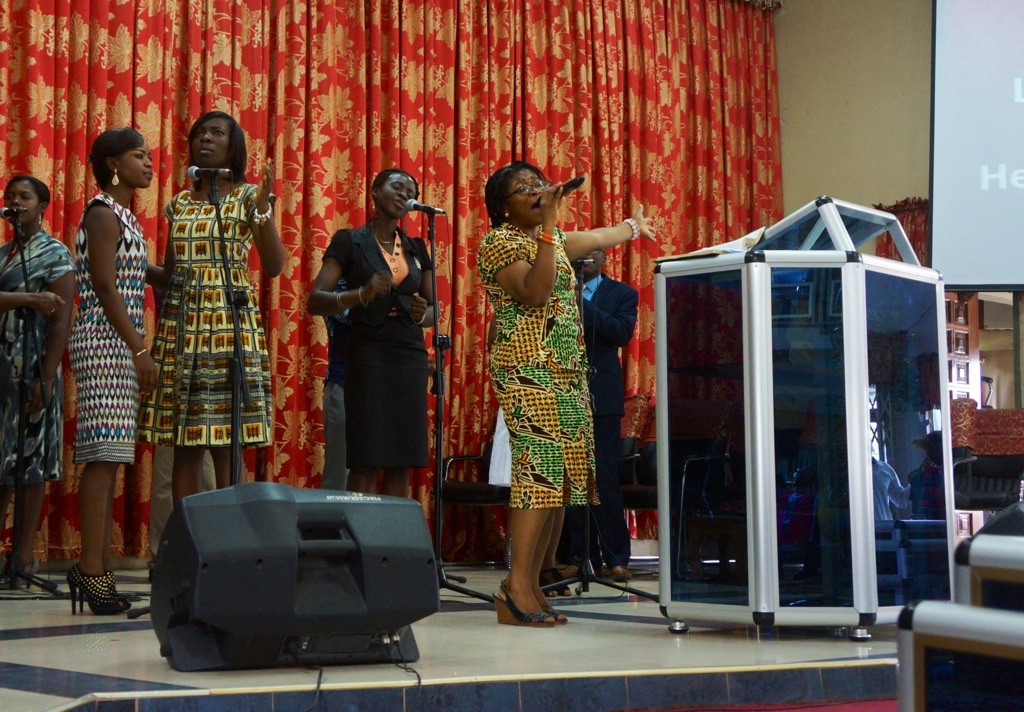
For attendees, who are very moved by the words and music, the message is of a very personal savior, reflected in hymns with words such as:
Amazing love
How can it be
That Thou my Lord
Should die
For Me
Sung repeatedly at high decibels, led by a woman, with much hand waving and other movement among the congregants.
When the pastor takes over he referred to the events of this week and the court decision upholding the election. Some people stocked rice and food, some made plans to leave the country, he said, but peace had prevailed, not because the politicians brought peace, but because The Lord brought peace. Many amens and hallelujahs. His sermon involved a rather obscure passage of the Old Testament, book of Samuel, in which the crippled son of Jonathan was restored to his inheritance by King David. The pastor managed to construct some 45 minutes of preaching around this story. Not my cup of tea, but the congregation seemed to like it. Dr. Annie, her daughter, Saint Anne and Joe and Ida were clearly into the service, but as to the Chicago group, not so much.
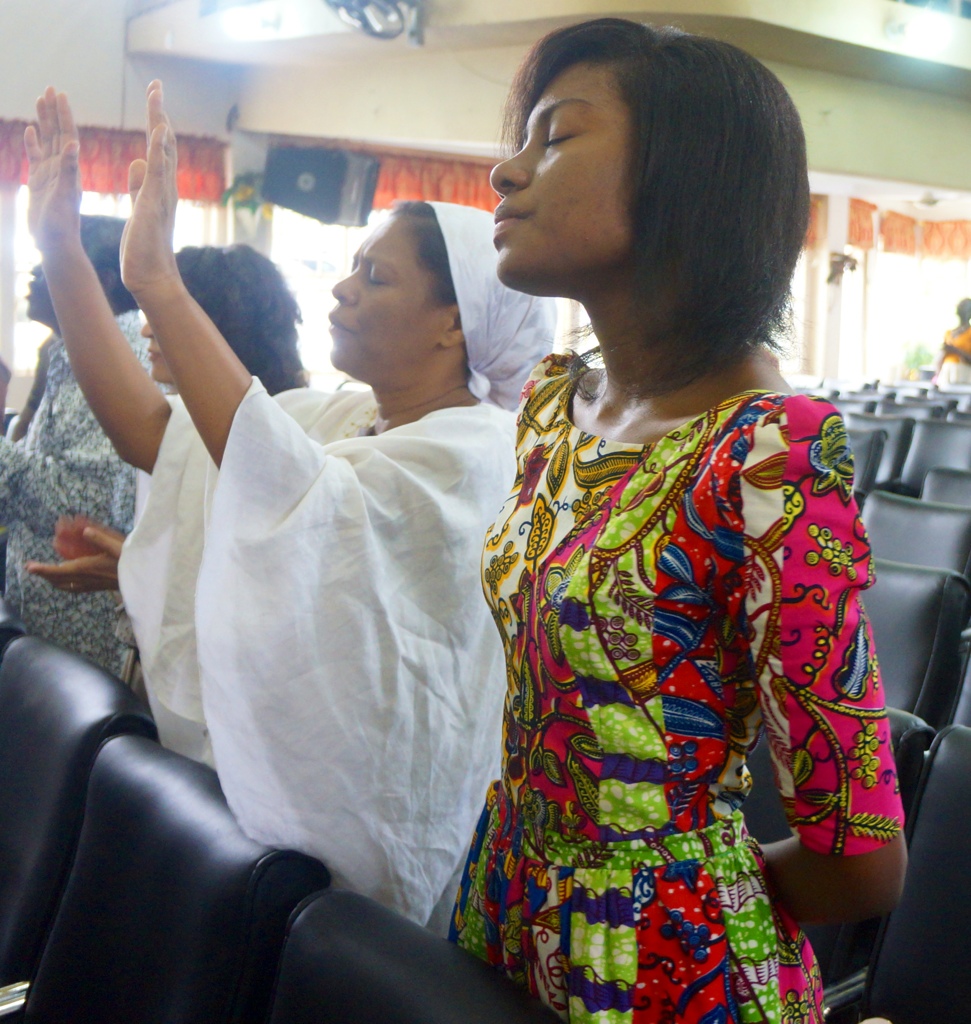
We left for Accra at about noon and drove for almost five hours on roads that sometimes were very good, and other times not. Overall, the road is decidedly improved over what we encountered several years ago. We passed through many towns with their familiar assortment of foods and wares for sale. I got lessons from Sola on the operation of the pharmaceutical industry and the roles of CROs ( Contract Research Organizations) in that process. He and Dick have talked about forming a CRO for West Africa.
Arriving at the airport at 4:45, four hours early for our flight, we checked our luggage and walked to the Landings restaurant, not far from the airport. Service was extremely slow, but the food was quite good. We went there to meet a friend of Funmi (whose name, the Kipharts and I learned after two years, is actually pronounced,”Foomi”) who she had taught at the U of C and who was practicing at the largest hospital in Accra. Funmi’s friend arrived late, with her 10-year old daughter, so we could spend only a very short time with them.
Walked back to the airport, cleared immigration and went to the business class lounge for a while (the Kipharts and Olopades snuck me in). Flight to Frankfurt took off just a little late, and I’m doing my last post now, in steerage. I think I’ve concluded that the main reason to fly business class may not be the roomier, more comfortable seats, but the special, shorter lines for everything, and club access. When you travel with Funmi, though, you get into clubs anyway, so that advantage disappears. After a 3-hour layover in Frankfurt (again admitted to the business class club), we fly United to Chicago, arriving at 10:30 tomorrow morning. Wish I could have slept like these guys.
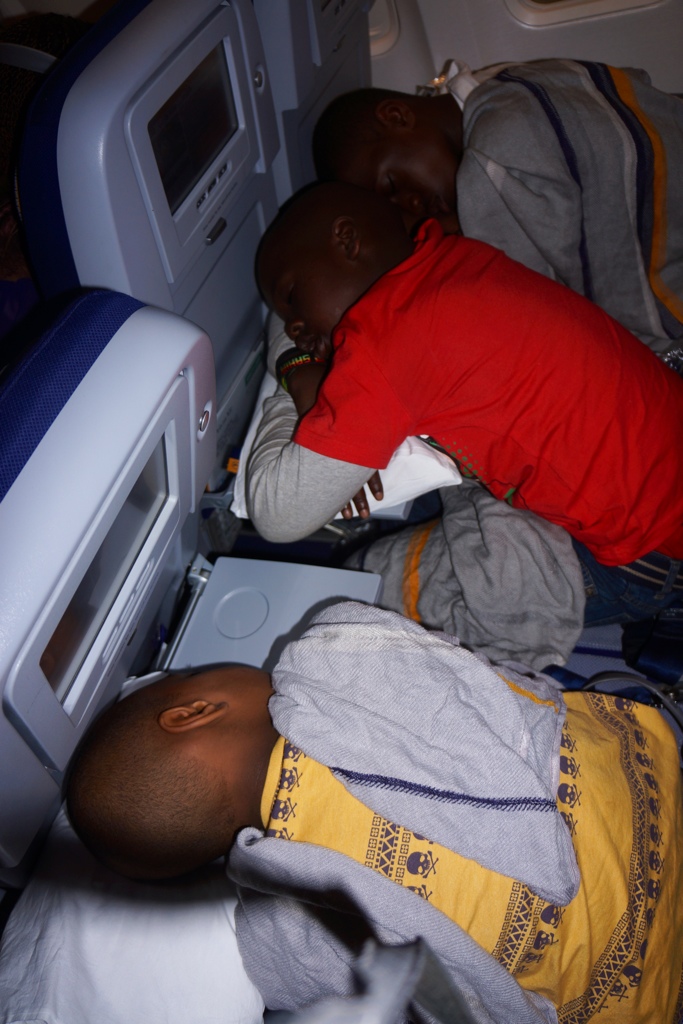
********************************************************************************************
Now for a few reflections.
Overall, amazing. Best of four wonderful trips to Ghana, in large part because it included Nigeria, for the first time.
Nigeria. Going there with the Olopades was fantastic. On the one hand, we had the royal treatment of being escorted guests of the Governor of Ekiti State. On the other, we had the very personal experiences of meeting both Funmi and Sola’s mothers and seeing their homes. We met fascinating people, ranging from young professionals to friends of the Olopades to university professors to governmental officials. We saw market women celebrating and kings given SUVs. We made contact with people with whom the Kipharts and Olopades (with us as minor participants) probably will have continuing contact/projects. Barbara, from Root Capital, certainly falls into that category.
We began to get a sense of the power of Nigeria, as the largest country in Africa. It’s been said that if Africa is shaped like a gun, Nigeria is its trigger. And we saw, up close, the governor of Ekiti State, who has the potential to emerge as a national force in Nigeria. He uses his initials, JKF, which for slightly dyslexic old farts evokes memories of JFK. JKF even has an attractive, bright, fashionable wife in Bisi. This may be jumping the gun a bit, because Ekiti State, at 2.7 million people, is a very small part of Nigeria (but it is larger than the country of Botswana in population; had to sneak one last fact into this reflection). We emerge with a more realistic picture of the country as a whole than that portrayed in the US press. The violence in the North does not pervade the whole country. There are areas in which Muslims and Christians live together in peace, including in Lagos.
Ghana. Seemed odd going to Ghana and not being under the constant guidance of Peter Eduful. We all missed him. It was wonderful to see old friends–Joe, Ida and Daniel Kwarteng, Dr. Annie and Saint Anne, Alex Owasu, and the two chiefs we met with from Bonkwaso and Abesua. Witnessing the growth of the pineapple farms was very impressive, but I definitely missed going into villages the way we have on our prior trips. Because of the focus that the Olopades provide, the trip was more productive than prior trips, especially connecting with new partners at KNUST and KATH (most notably Dr. Daniel Ansong). It’s always a pleasure to meet new people, like Dr. Annie’s son, Robert, and Emily, the U of C med student who is doing a project with Dr. Annie, and to get unexpected surprises, like connecting with the Taylor family. For me, it was also a great pleasure to spend time with Peter’s oldest son, Alex, who I’d met only very briefly before.
I enjoy the photography I’m able to do on these trips and, from that standpoint, the trip was okay, but definitely not great. The more productive a trip and the faster the pace, the less opportunity for the kind of photography that I enjoy. Taking pictures at or after a meeting is, well, dull, but I do recognize the need to do some documentation of the trip. And, as photography was not at all the primary reason for the trip, in any case. I’ll be quite content with whatever limited number of decent photos may emerge.
We all come away from this annual trip enriched by the tremendous amount we learn, both substantively (most of which I’ve already forgotten) and about life (at least some of which I hope to retain). Funmi referred to her Chicago family and her Nigerian family on the trip. And we all certainly feel that we have a Ghanaian family. It’s this strong, palpable sense of family that makes these trips so special. The Kipharts, Olopades and Kanters just plain have a good time together.
Susie often talks about the Great Weaver, a reference to whatever force has made all of this happen and develop as it has over ten years, and brought everyone together. I have to admit, Susie, that I’ve felt that this was a bit corny. But I also have to admit that I’m now in serious danger of becoming a believer. When you think about, see and feel the remarkable set of circumstances and connections that has made all of this possible, it’s hard not to believe that there’s some force at work. Carol and I are incredibly grateful to be a small part of this beautiful tapestry.
August 31
Breakfast at the inn, and then a couple hours to talk about strategy, going forward, including development work for Global Health, the approach and the story to be told. A young woman, carrying her son and a large bowl of cauliflower, passes by, as we talk.
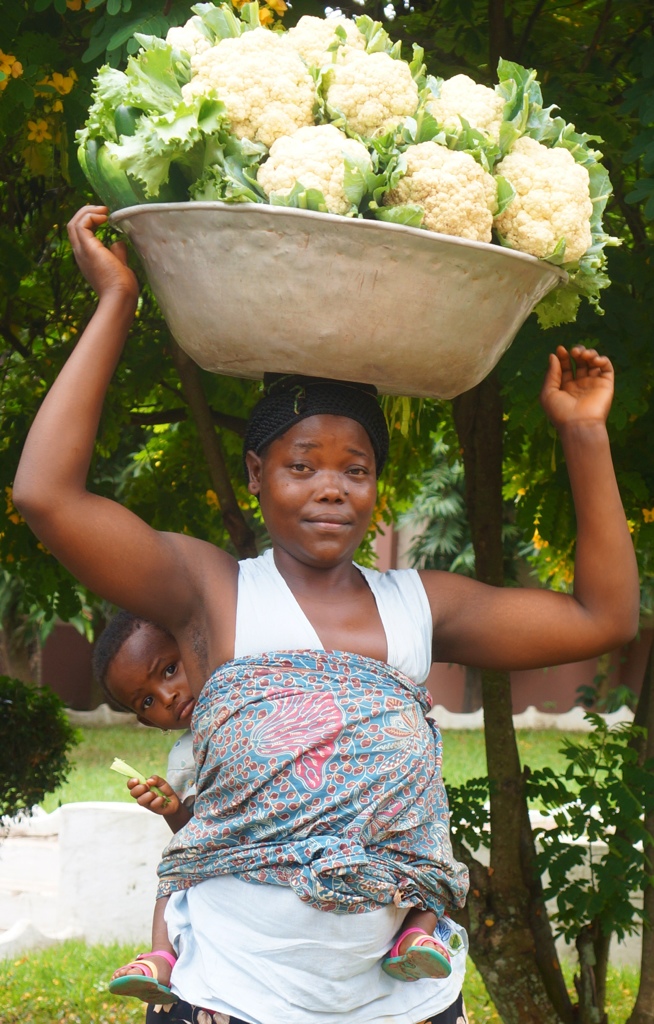
Drive over to The Golden Tulip for a lunch with 16 people, including, in addition to those mentioned on previous days, the chiefs of the remote villages of Abesua and Bonkwaso, who we’d visited on several prior trips. Dick has a special fondness for the Abesua chief and the chief of Bonkwaso and I have a special relationship, developed over our having seen each other for four years. He is referred to as Nana, and he calls me Nana II.
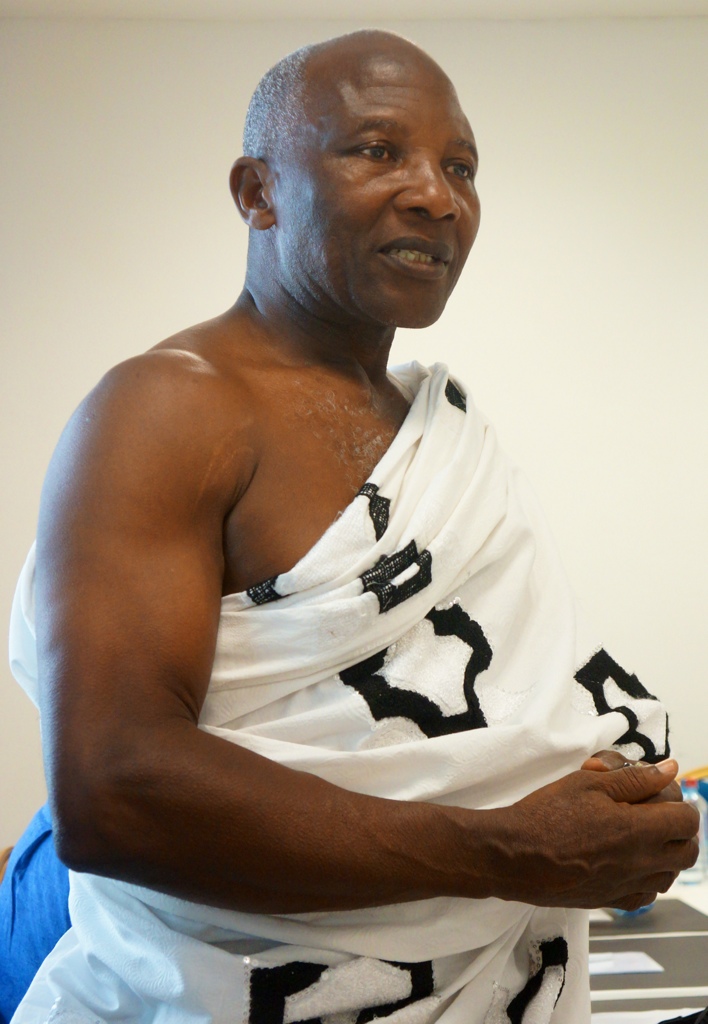
Also involved in the meeting were Gabriel Barima, the district chief executive from Moncraso, the district in which those villages were located and two officials from the water and sanitation department of that district.
The meeting over lunch lasted three hours, with communications with the chiefs translated (though they both speak and understand some English). The district officials spoke English quite well. There was a candid exchange of plans and needs on both sides, and many questions asked and answered. These chiefs and village officials seem to be very good prospective partners, because they all “get it”, and seem quite willing to contribute to the effort. Seems quite likely that we’ll work together, though exactly how will need to be worked out.
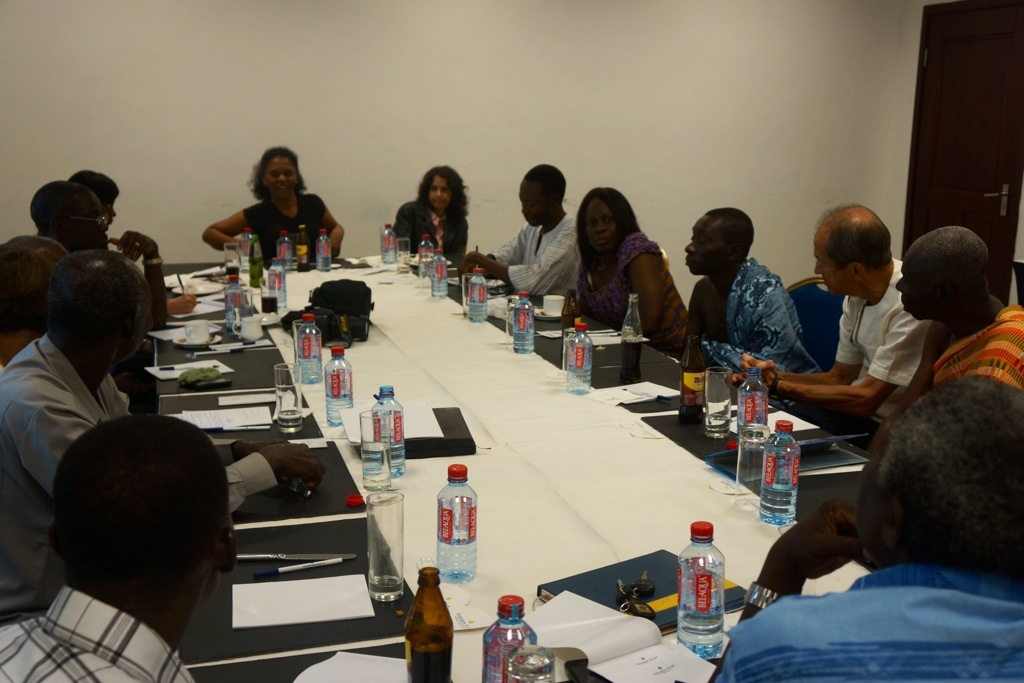
Talking after the meeting to Alex Owusu, the contractor and friend of Peter’s who we’ve been with each year, he asks about Carol and I explain that she had to go home after Nigeria. He asks me to “snap” a picture of him to show her, and tells me that he remembers the dance we did and does a few steps. He’s referring to the Israeli dance to “Mayim” (water) which we taught the villagers at the dedication of one of the wells Carol and I donated. He says he also has the cover (the challah cover) that we gave him, purchased at the Jewish community we visited two years ago. This is a very nice moment for me, symbolic of the real and continuing relationships we’ve formed in Ghana.
Back to the Four Villages, where Susie had invited a family to stop by, the parents of the husband of which Susie knew from church. We expected a short visit, but they wound up staying four and a half hours and being included in dinner. Kristin and Buck Taylor live in Montana, though Kristin grew up in New York and Buck in Chicago. They had brought their 10-year old daughter, Kendall, and 12-year old son, Ben, for a 3-month stay in Ghana. Also joining the Taylors was a 35-year old Ghanaian man named Kodua, who ran an NGO relating to health services.
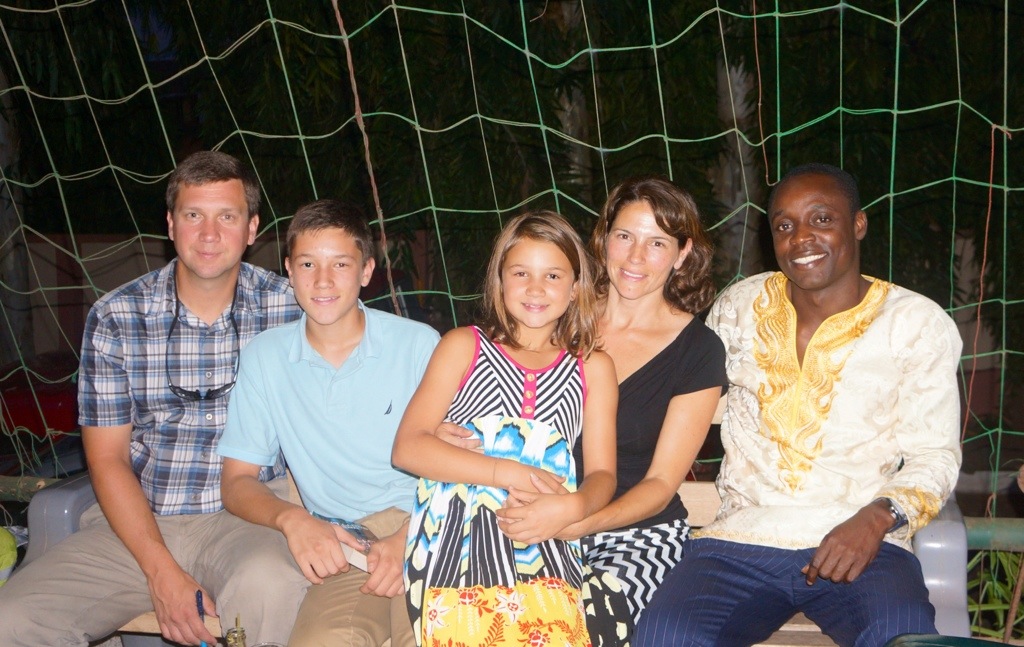
Buck, a public health person, and Kristin, a lawyer interested in sustainable development, will volunteer here, and the kids will go to school. This is the third extended trip the family had taken, the others being to Ecuador and to some Southern states in the US. All of the adults told the kids that they were so fortunate to have this experience, and, though they miss their friends and soccer, Kendall and Ben seemed reasonably content (or, at least, resigned). I grabbed a seat near Kendall at dinner to chat her up.
Another large dinner served on the porch of The Four Villages, with about eighteen people, including the Taylor party. The Taylors had wanted to get together with Dr. Annie and Joe Kwarteng while they were in Ghana, so the dinner provided them an unexpected opportunity to meet Annie and Joe in person. Food was excellent and conversation good over dinner. We concluded the evening by going around the table with everyone giving comments on the trip that we unanimously agreed was fabulous. There is a warm, family feeling between the Chicago and Ghana groups, exuded in everybody’s comments. Funmi says that we need to get dates on the calendar for next year’s trip. As Dr. Annie leaves, she gives me a painting as a gift for Carol and Annie’s son, Robert, who is just starting a residency and who I’ve met for the first time on this trip, rolls it for me and goes down to the car to get a rubber band to secure it.
August 30
A productive, but not a photogenic, day.
We set out early for the four-hour drive to Kumasi, passing through towns lined with roadside shops, many bearing religious names. Here are a few: Christ is the Almighty God Plumbing Works, God First Catering Service, Everlasting Glorious Furniture Store and Amazing Grace Super Market.
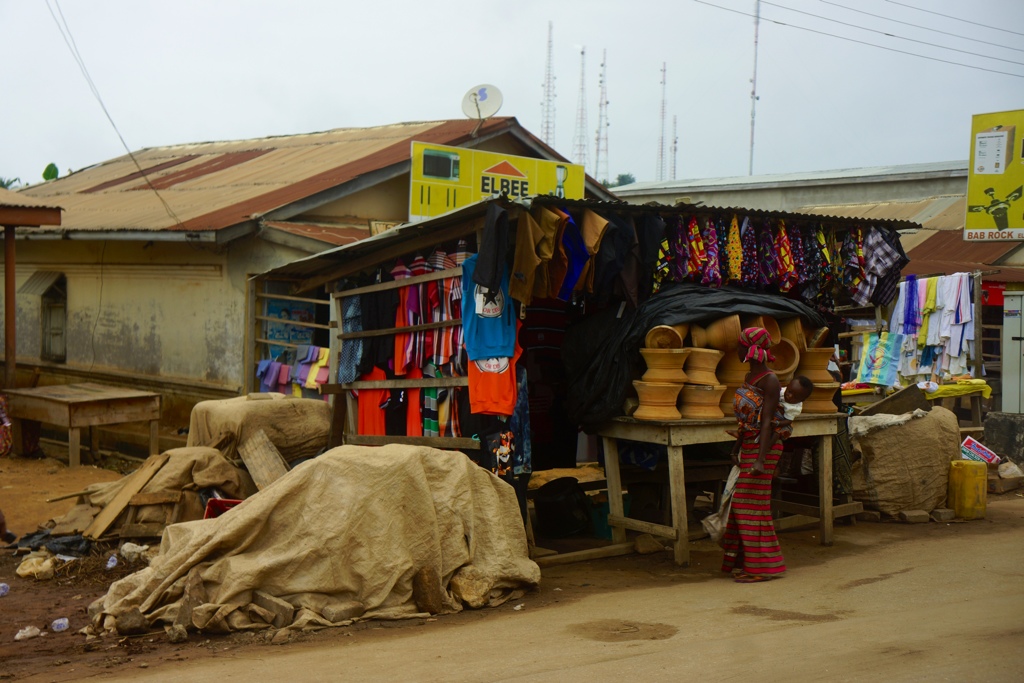
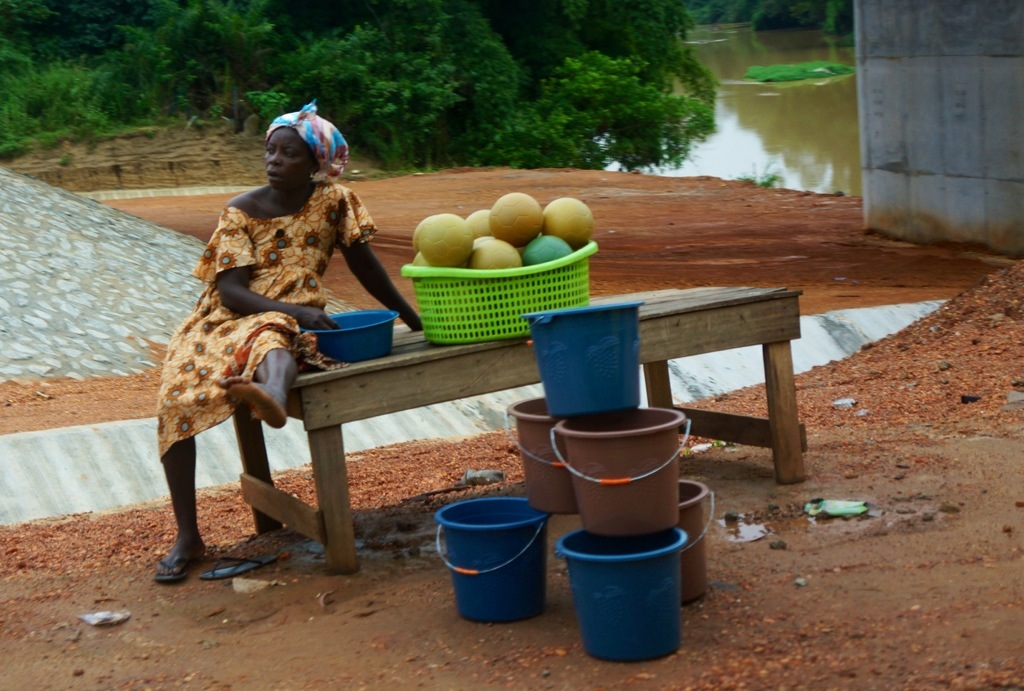
I am riding with Joe and Sola. We talk some about yesterday’s big court case announcement, involving the contest of the legality of the Ghanaian presidential election. There had been fears that the decision, eight months in the waiting, might provoke violence. The court upheld the validity of the election of Mr. Mahama, finding that any irregularities were not widespread, and would not have affected the outcome. Happily, the other side accepted the outcome of the election, and so there was no violence.
I learned about Sola’s decision to join Funmi in Global Health at the U of C. He had been a tenured professor at the University of Illinois, Chicago, where he’d been on the faculty for nineteen years. While their kids were in school at home, Sola and Funmi had made a decision to remain in their positions, but now that the kids were older, Sola decided to leave his tenured position to become a Professor at the University of Chicago in order to join Funmi in developing the Global Health Initiative there. I talked with Sola about the difficulties of being mentored and advancing as the sole Black doctor at UIC, which paralleled what I knew about the advancement of minorities in large law firms. We compared notes about the process of our leaving secure positions to strike out elsewhere.
I am going to conflate two meetings, because the issues and results were similar. The Global Health Initiative has developed formal relations with some fifteen hospitals and universities in many countries around the world. (They have one with Ibadan, in Nigeria.) These relationships are formalized with a Memorandum of Understanding that sets a template for future projects, each of which must be agreed to in a separate written agreement. They had proposed signing MOUs with two related entities in Kumasi, KATH (Komfo Anokye Teaching Hospital) and KNUST (Kwame Nkrumah University of Science and Technology). We met separately with doctors and administration people, and it’s clear that both MOUs will be signed in short order. Sola handled both meetings very skillfully. Several months ago the U of C had sent a team of three Global Health students, which combined with three students provided by KNUST, evaluating wells built by the Kipharts and it’s this work that led to the MOUs.
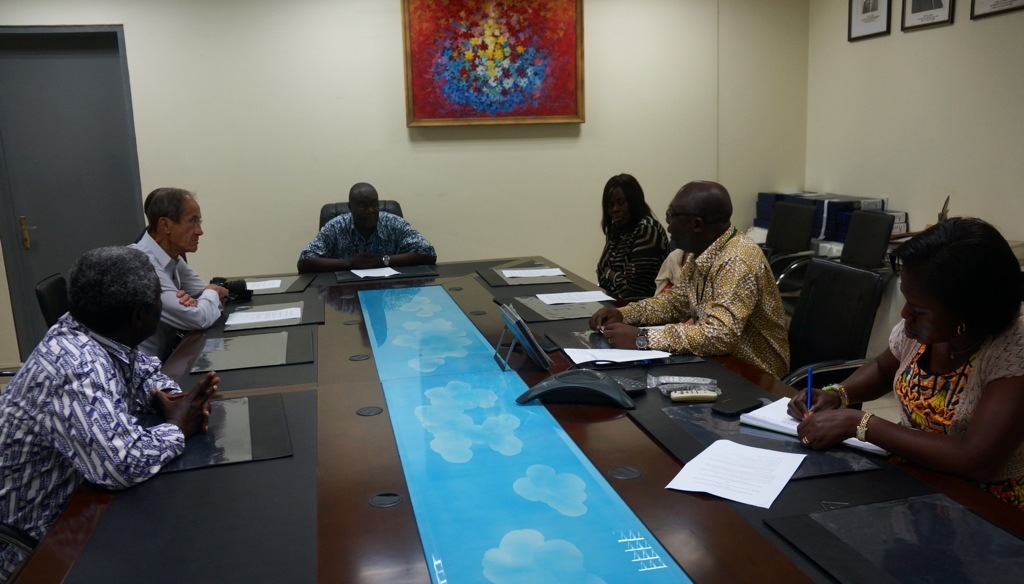
We drove to the Kumasi Maternity and Childhood Clinic to see Dr. Annie, who runs the clinic and who the Kipharts have supported for many years. Dr. Annie is an amazingly energetic, compassionate and engaging person, who is from Madagascar and received her medical training in the Ukraine.
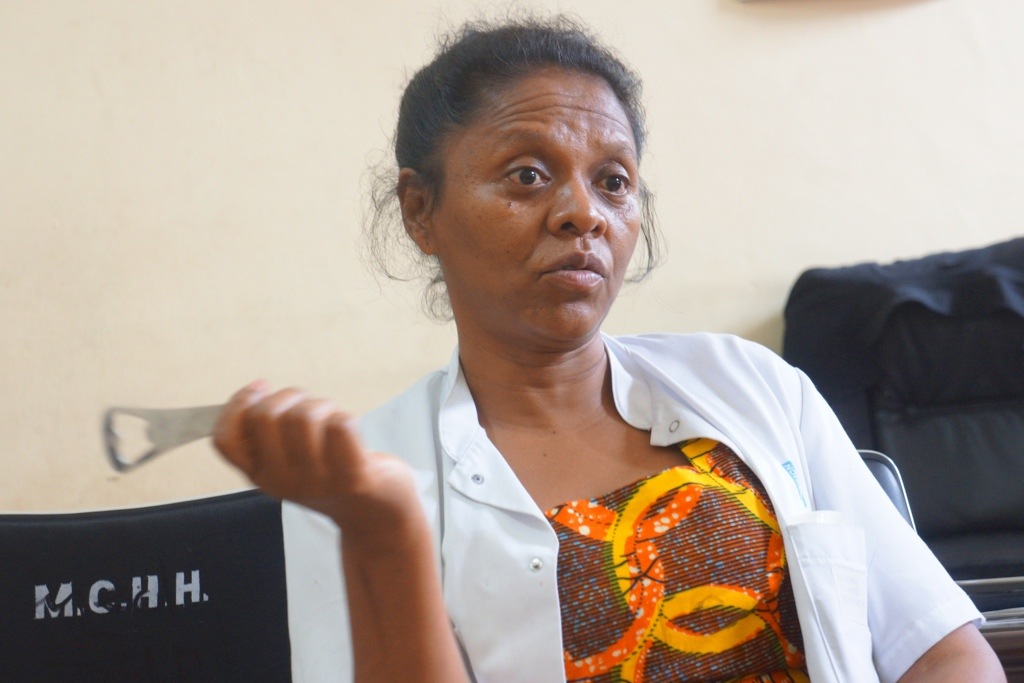
At the clinic, we saw Emily, a first year medical student at the U of C, who was spending three weeks at the clinic on a project through the Global Health Initiative. Each time we return to the clinic, we see many improvements, but none have been more dramatic than the beautiful new lab, funded by a foundation in Spain called Grifols, which came about because of friendship and investor relationships between Dick and Grifols.
Drove to The Four Villages Inn, our home in Kumasi, where we were greeted by Chris, the proprietor. Chris’ Ghanaian wife, Charity, is in Canada, visiting their kids. The Kipharts, Olopades and I met with Alex Eduful, the eldest son of Peter Eduful, who died suddenly about a year ago. This was a tremendous blow, both personally and to the work the Kipharts are doing in Ghana, because Peter was the indispensable point person for all of that work. The meeting, to gauge Alex’s interest in aiding in continuing that work was delicate, because the whole approach to the work has changed now that it will be done through the Global Health Initiative. The Kipharts were very clear about the changes. The meeting went well, and Alex is to prepare a proposal for the Olopades, for analysis of the 78 wells the Kipharts have built in Ghana, based on what we discussed.
As the meeting ended, the rest of the fifteen people invited for a dinner with us on the porch of the inn began to arrive. Most of them are people I’ve mentioned earlier in this blog, so I won’t go into the list now. Dinner was quite excellent, and ended with another happy birthday song and cake for Dick, as today is his actual birthday. After the guests left, our “gang of five” debriefed the day and discussed follow up action.
|
|













